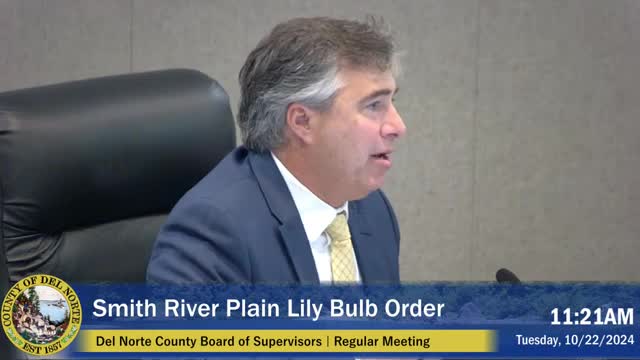Water quality crisis threatens agriculture and aquatic life
October 23, 2024 | Del Norte County, California
This article was created by AI summarizing key points discussed. AI makes mistakes, so for full details and context, please refer to the video of the full meeting. Please report any errors so we can fix them. Report an error »

In a recent government meeting, officials discussed ongoing concerns regarding water quality in the Smith River Plain, particularly the impact of agricultural practices on copper contamination. The meeting highlighted the complexities surrounding the relationship between farming activities and water quality, with officials acknowledging that definitive answers regarding the effectiveness of voluntary efforts by growers to mitigate contamination are still pending.
A water quality monitoring program initiated two years ago aimed to assess copper toxicity levels and their implications for aquatic life. The program concluded this fall, and officials are currently analyzing the data, with plans to release a report before the draft of new regulations is made public. The findings will help clarify the connection between farming practices and copper levels in local water bodies.
During the meeting, it was noted that while copper is a naturally occurring element, its toxicity can be exacerbated by specific water quality factors, such as pH and hardness. Although current copper levels do not pose a human health risk, they present a significant threat to aquatic life, raising concerns among environmental advocates.
Public comments reflected a tension between agricultural interests and environmental protection. Some attendees expressed frustration over potential regulatory burdens on farmers, arguing that agriculture is a vital economic driver for the county. They questioned the necessity of stringent regulations when human health is not at risk and emphasized the importance of balancing economic viability with environmental stewardship.
Environmental advocates, including representatives from the Siskiyou Land Conservancy, urged the board to take decisive action to protect the Smith River ecosystem. They cited historical data on pesticide toxicity and its effects on local wildlife and human health, calling for increased monitoring and regulation to safeguard both the environment and community health.
As the board prepares to release its findings and consider future regulations, the discussions underscore the ongoing challenge of managing agricultural practices while ensuring the health of the Smith River and its surrounding ecosystems.
A water quality monitoring program initiated two years ago aimed to assess copper toxicity levels and their implications for aquatic life. The program concluded this fall, and officials are currently analyzing the data, with plans to release a report before the draft of new regulations is made public. The findings will help clarify the connection between farming practices and copper levels in local water bodies.
During the meeting, it was noted that while copper is a naturally occurring element, its toxicity can be exacerbated by specific water quality factors, such as pH and hardness. Although current copper levels do not pose a human health risk, they present a significant threat to aquatic life, raising concerns among environmental advocates.
Public comments reflected a tension between agricultural interests and environmental protection. Some attendees expressed frustration over potential regulatory burdens on farmers, arguing that agriculture is a vital economic driver for the county. They questioned the necessity of stringent regulations when human health is not at risk and emphasized the importance of balancing economic viability with environmental stewardship.
Environmental advocates, including representatives from the Siskiyou Land Conservancy, urged the board to take decisive action to protect the Smith River ecosystem. They cited historical data on pesticide toxicity and its effects on local wildlife and human health, calling for increased monitoring and regulation to safeguard both the environment and community health.
As the board prepares to release its findings and consider future regulations, the discussions underscore the ongoing challenge of managing agricultural practices while ensuring the health of the Smith River and its surrounding ecosystems.
View full meeting
This article is based on a recent meeting—watch the full video and explore the complete transcript for deeper insights into the discussion.
View full meeting
